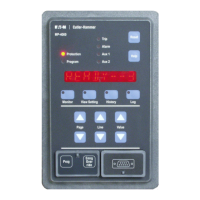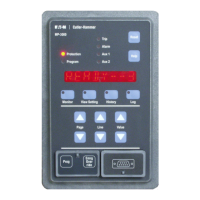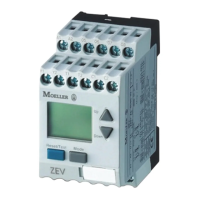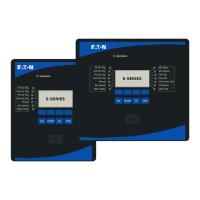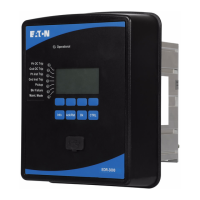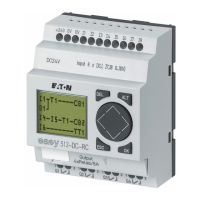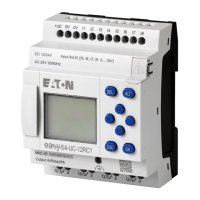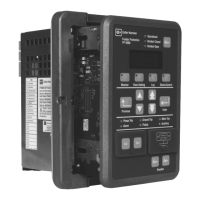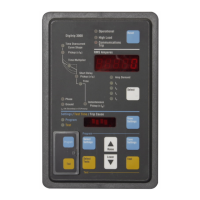13
Instruction Booklet IB02402001E
December 2010
Instructions for the Eaton Type
MPCV Network Protection Relay
EATON CORPORATION www.eaton.com
IB02402001E For more information visit: www.EatonElectrical.com
Instruction Bulletin
Effective: September 2004 Page 13
Instruction for the
Cutler-Hammer Type MPCV
Network Protection Relay
Technical Specifications
Electrical
Input Power
The Cutler-Hammer (Westinghouse) Type Relay is powered
from any two phases of the three transformer voltages or the
three network voltages. The General Electric type is
powered from any two phases of the three network voltages.
Voltage Range
The relay has a 125 Vac nominal input voltage and will
operate from 12 Vac to 190 Vac line to neutral, 3-phase.
Operating Frequency
The relay shall operate on 50 Hz or 60 Hz systems.
Power Consumption
The relay shall draw a power of 15 watts maximum in a
balance 3-phase voltage source.
Power-Up Voltage
The relay minimum power-up voltage is 90 Vac, 3-phase.
Loss of Power
The relay shall retain all the programmable settings in a non-
volatile memory during a power loss. The memory
storage has 10 years shelf life at 85°C.
CT Input
The relay CT burdens are virtual short circuits, less than
2 milliohms, rated at 15 amperes continuous.
Phasing Voltage Input
Each of the voltage channels has nominal input impedances
of 500,000 ohms.
Auxiliary Input
The relay has three auxiliary input channels. The channels
accept dry contact input that are internally driven with an
open circuit voltage of 13 Vdc nominally, and approximately
10 mA when closed.
Indicator Lights
TRIP Indicator
■ Flashes when normal trip is initiated, incorrect phase
rotation is detected or ROBO is active.
■ ON when crossed-phase or rolled-phase conditions are
detected.
■ OFF when no trip condition is detected.
CLOSE Indicator
■ ON until phasing voltage no longer satisfies the ML,
PL settings.
■ OFF when no close condition is detected.
FLOAT Indicator
■ Flashes when pendant is active.
■ ON when the relay is energized and not commanding a Trip
nor Close.
FAIL Indicator
■ ON when micro-controller is not operating properly.
Trip and Close Contacts
Rating: The relay contacts are capable of 100,000 make
operations for 20 amperes resistive at 240 Vac and 2 hp at
240 Vac motor load.
■ Close Operation:
Continuously close until phasing voltage no longer
satisfies the ML, PL settings.
Contacts: NO
■ Trip Operation:
Contacts: NO
1. Continuous Open/Close operation until tripping condition
is removed, Phase sequence is incorrect, or Remote Open
Block Open command is active.
2. Continuously ON until crossed-phase condition is cleared.
ANSI/IEEE SWC Compliance
IEEE Standard Surge Withstand Capability (SWC) Test for
Protective Relays and Relay Systems IEEE C37.90.1 — 1989.
Radio Frequency Withstand Capability
IEEE Standard Withstand Capability of Relay Systems to Radi-
ated Electromagnetic Interference from Transceivers IEEE
C37.90.2 — 1995 (35 V/m field strength).
Harmonic Immunity
The relay shall not exhibit any spurious output when sub-
jected to the following phasing voltage (Vph) harmonic con-
tents with a fundamental magnitude of 6 Vac maximum.
■ Fundamental = 41%
■ 3rd Harmonic = 6%
■ 5th Harmonic = 50%
■ 7th Harmonic = 2%
■ 9th harmonic = 1%
With a network voltage of 125 Vac (no harmonics).
Mechanical
Construction
Case: 0.15" thick, Brass
Bracket: Cold rolled steel
Terminal Block: Phenolic/Thermo set
Terminal Pins: Plated Brass
Wiring
The relay uses Teflon insulated wires with silver copper con-
ductor rated at 200°C, 1000 volts.
Weight
12 lbs. (5.4 kg)
Overall Dimension
10.25 x 7.10 x 4.25 inches (260.4 x 180.3 x 108.0 mm)
Environmental
Operating Temperature
The relay shall operate satisfactorily in ambient temperature
range of -20°C to +110°C with excursion to 120°C.

